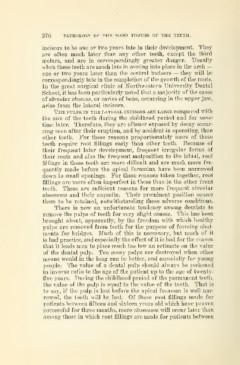Page 534 - My FlipBook
P. 534
276 PATHOLOGY OF THE HABD TISSUES OF THE TEETH.
incisors to be one or two years late in their development. They
are often much later than any other teeth, except the third
molars, and are in correspondingly greater danger. Usually
—
when these teeth are much late in coming into place in the arch
one or two years later than the central incisors — they will be
correspondingly late in the completion of the growth of the roots.
In the great surgical clinic of Northwestern University Dental
School, it has been particularly noted that a majority of the cases
of alveolar abscess, or caries of bone, occurring in the upper jaw,
arise from the lateral incisors.
The pulps in the latekal incisors are large compared with
the size of the teeth during the childhood period and for some
time later. Therefore, they are oftener exposed by decay occur-
ring soon after their eruption, and by accident in operating, than
other teeth. For these reasons proportionately more of these
teeth require root fillings early than other teeth. Because of
their frequent later development, frequent irregular forms of
their roots and also the frequent malposition to the labial, root
fillings in these teeth are more difiBcult and are much more fre-
quently made before the apical foramina have been narrowed
down to small openings. For these reasons taken together, root
fillings are more often imperfect in these than in the other front
teeth. These are sufficient reasons for more frequent alveolar
abscesses and their sequellae. Their prominent position causes
them to be retained, notwithstanding these adverse conditions.
There is now an unfortunate tendency among dentists to
remove the pulps of teeth for very slight causes. This has been
brought about, apparently, by the freedom with which healthy
pulps are removed from teeth for the purpose of forming abut-
ments for bridges. Much of this is necessary, but much of it
is bad practice, and especially the effect of it is bad for the reason
that it leads men to place much too low an estimate on the value
of the dental pulp. Too many pulps are destroyed when other
means would in the long run be better, and especially for young
people. The value of a dental pulp should always be reckoned
in inverse ratio to the age of the patient up to the age of twenty-
five years. During the childhood period of the permanent teeth,
the value of the pulp is equal to the value of the tooth. That is
to say, if the pulp is lost before the apical foramen is well nar-
rowed, the tooth will be lost. Of those root fillings made for
patients between fifteen and sixteen years old which have proven
successful for three months, more abscesses will occur later than
among those in which root fillings are made for patients between


